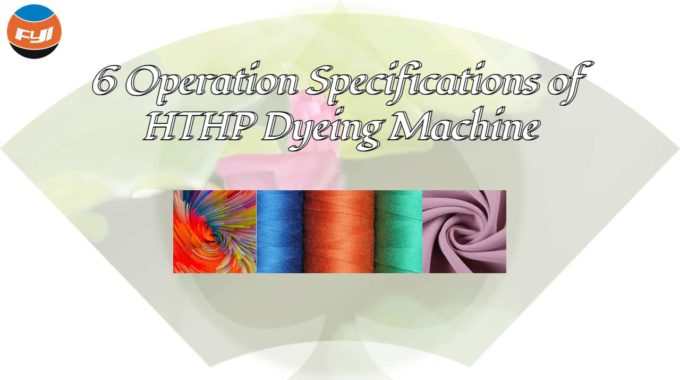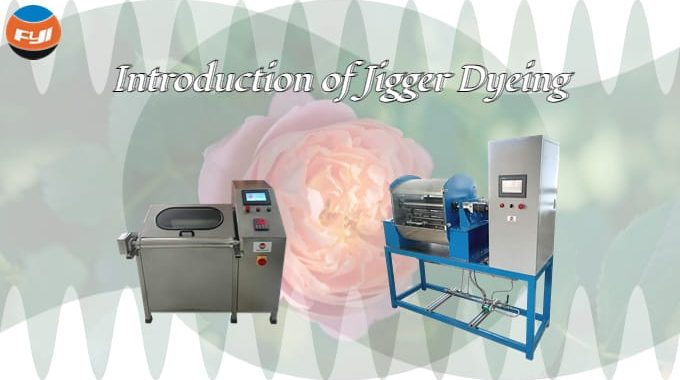
6 Operation Specifications of HTHP Dyeing Machine
The dyeing equipment employed under high temperatures and high pressure is known as an “HTHP dyeing machine.” There are some risks associated with using the HTHP dyeing machine. The safety concerns that must be taken into account when using it are briefly described below.
Contents
Opening and closing the cover
The steam valve must first be closed to stop the heat source once any high-temperature, high-pressure dying is complete. The pressure lowering valve must then be opened, and the lid can only be released when the pressure drop below 0 MPa and temperature drop below 85℃ inside the dyeing machine .
Under these circumstances, if the lid still won’t open, it’s best to check the instrument first to make sure it won’t break down and fail to accurately display the residual pressure. To avoid hazard, don’t forcefully open the cover.
Additionally, even though the fabric feeding machine is operating normally, if the temperature inside the machine has not yet reached 95 °C, do not close the pressure relief valve and attempt to allow the air inside the machine to exhaust outside. Particularly the semi-filled dyeing machine, since the machine’s saturated steam pressure typically begins to press when the temperature exceeds 99 °C. A virtual pressure will be created in the machine if the exhaust valve is closed too soon, and the color may also subtly shift. In addition, it will result in a “air wave” in the circulation pump, which will lead to fabric knots and blockages in the machine.
Exclude blocking cloth
If an HTHP dyeing machine is utilized incorrectly, there will be varying degrees of blocking phenomena, primarily for the following four reasons:
- After the fabric enters the machine, it must move steadily and slowly for three to five minutes before the door is closed and the material is fed. Mechanical blockages can occur when mechanical devices, such as liquid return valves and nozzles, have not been modified owing to a change in processing types and the devices are eager to start.
- After entering the machine, some light, thin, and high-density textiles, like Chun Yafang and polyester taffeta, float on the liquid’s surface rather than sink. The fabric can be kept from tying up and obstructing the cloth by using the full overflow filling method and the influence of the liquid return valve, heat exchanger, and filter screen. To reduce the likelihood of cloth knotting, degassing agents can be added to the dyebath to remove air from the fibers. In this situation, the right method should be developed based on the fabric type, and the right auxiliaries should be used to avoid failure.
- The operator should continue to pay attention to monitoring the fabric’s operation in the dyeing machine after placing the fabric in the machine. When it is discovered that the operation is abnormal, the recoil blocking device should be turned on right away to fix the problem before it gets worse.
- It is important to check to see if the foam in the dye bath increases after the fabric is fed into the machine. It is simple to produce inadequate foam suppression, leading to “air stroke” and blocking of the cloth, if the defoamer is not used or the amount is insufficient. So that the foam suppression effect is better, the defoamer should be added before the foam appears during dyeing.
If the temperature in the dyeing machine surpasses 100 °C while the fabric is being dyed, pressure will be created inside the machine, and it should not be scrubbed with a damp towel. The glass will experience significant thermal expansion and contraction as a result of the temperature difference, which can cause cracking and serious accidents. The stop valves at the upper and lower ends of the water level glass tube should also be promptly closed when the liquor ratio is altered.
Safety and accuracy in sampling
In order to match the color of the standard sample, it is best to take a dyed sample on each tube for fabrics dyed using a double-pipe or multi-pipe overflow jet machine. While every tube produces a constant color in general, there are occasionally color variations between tubes for the reasons listed below.
- The length of the cloth in each tube is different.
- An anomalous heat exchanger cycle is present.
- A partial blockage occurs as a result of a long period of time between filter cleanings.
- The feeding is concentrated and happening quickly.
As a result, it is important to monitor whether these components are operating regularly during daily production and to address any issues as soon as they arise. When sampling, the fabric should be pulled out of the dyeing machine, and do not put your hands into the machine to cut the sampling cloth. When starting the machine after sampling, set the machine’s cloth speed to the slowest setting and then gradually increase it to prevent unneeded issues.
Strengthen daily maintenance
The sealing ring is crucial for daily maintenance of the HTHP dyeing machine, whether of a tiny prototype or large production. Practice has shown that the same fabric sequence and pre-treatment can occasionally result in cylinder differences. This is primarily caused by the variance in how well each dyeing machine seals on its own. The color difference will be affected by air leakage from one joint, which will also substantially waste heat energy and possibly even be dangerous. As a result, it is crucial to enhance the dyeing machine’s sealing capabilities and to promptly make necessary adjustments to the air leakage.
Check the “Contrast Table of Temperature and Saturated Steam Pressure Constant” (see the table below) to see if the safety valve, thermometer, and pressure gauge are normal as well. If there is any discrepancy, you must check it right away in order to identify the issue and address it in a timely manner.
Avoid making dangerous assumptions about the pressure of 0.2MPa/m^2 based solely on the thermometer reading of 130°C.
Finally, the worn parts should be inspected and maintained every month. What’s more, the dyeing machine should be overhauled and maintained once a year, and oil should be added once a day. The major device components should also be repaired and maintained once.
| Pressure/MPa | Temperature/℃ |
| 0.00 | 99.1 |
| 0.02 | 104.3 |
| 0.04 | 108.9 |
| 0.06 | 113.0 |
| 0.08 | 116.6 |
| 0.10 | 119.9 |
| 0.12 | 123.0 |
| 0.14 | 125.9 |
| 0.16 | 128.6 |
| 0.18 | 131.1 |
| 0.20 | 133.4 |
| 0.22 | 135.6 |
| 0.24 | 137.7 |
| 0.26 | 139.7 |
| 0.28 | 141.6 |
| 0.30 | 143.4 |
| Resistance /Ω | Temperature/℃ |
| 100.00 | 0 |
| 103.90 | 10 |
| 107.79 | 20 |
| 111.67 | 30 |
| 115.54 | 40 |
| 119.40 | 50 |
| 123.24 | 60 |
| 127.07 | 70 |
| 130.89 | 80 |
| 134.70 | 90 |
| 138.50 | 100 |
| 142.29 | 110 |
| 146.06 | 120 |
| 149.82 | 130 |
| 153.58 | 140 |
| 157.31 | 150 |
Standardized practice and instruction
Before starting their jobs, operators of HTHP dyeing machines must complete training.
Comments are closed.



Thanks for a wonderful share. Your article has proved your hard work and experience you have got in this field.
We are totally excited to have discovered the blog, it is toally what my friends from work and I have been hoping for. The up to date info on this web page is very needed and is going to help my friends and I quite often.
I found so many entertaining stuff in your blog, especially its discussion. From the tons of comments on your articles, I guess I am not the only one having all the leisure here!
I really enjoy simply reading all of your weblogs. Simply wanted to inform you that you have people like me who appreciate your work.
This is such a great resource that you are providing and you give it away for free. I love seeing blog that understand the value of providing a quality resource for free.
Very interesting topic. Many articles I come across these days do not really provide anything that attracts others like yours, but believe me the way you interact is literally awesome I do respect that so much.
This is a fantastic article. This is, in my opinion, one of the most well-written pieces ever. Your work is outstanding and inspirational.
Your blog has quickly become one of my favorites to read.
What a remarkable blog! The author’s expertise shines through in every post, delivering valuable insights and thought-provoking content that keeps readers engaged and enlightened.